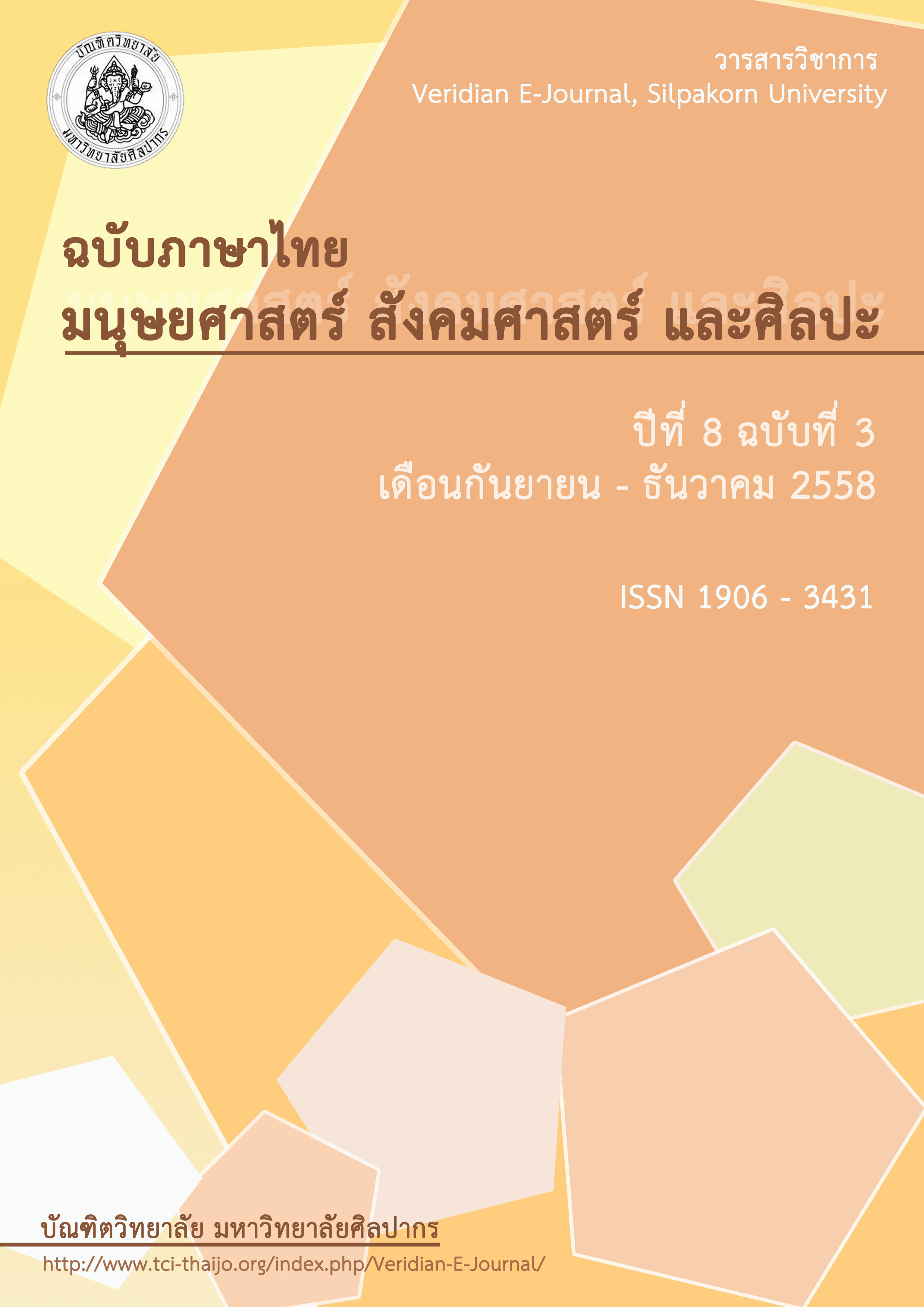การพัฒนาตัวชี้วัดคุณภาพชีวิตด้านสุขภาพของผู้ต้องขังในเรือนจำไทย
Main Article Content
Abstract
บทคัดย่อ
การวิจัยครั้งนี้มีวัตถุประสงค์เพื่อ 1 ) พัฒนาตัวชี้วัดคุณภาพชีวิตด้านสุขภาพของผู้ต้องขัง 2) ประเมินคุณภาพชีวิตด้านสุขภาพของผู้ต้องขังในเรือนจำไทย ดำเนินการวิจัย 3 ขั้นตอนคือ 1) ร่างองค์ประกอบและตัวชี้วัดโดยการสังเคราะห์เอกสารและประชุมกลุ่มเจ้าหน้าที่สายการแพทย์ในเรือนจำ 2) พัฒนาตัวชี้วัดโดยระเบียบวิธีวิจัยเทคนิคเดลฟาย (Delphi Technique) จากผู้เชี่ยวชาญ 21 ท่าน 3 ) ประเมินคุณภาพชีวิตด้านสุขภาพของผู้ต้องขัง จากกลุ่มตัวอย่าง 2 กลุ่ม ได้แก่ กลุ่มเจ้าหน้าที่สายการแพทย์ในสถานพยาบาลเรือนจำทั่วประเทศ 139 แห่ง 139 คน โดยวิธีการเชิงปริมาณ และกลุ่มผู้ต้องขังผู้รับบริการในสถานพยาบาลเรือนจำขนาดเล็ก กลางและใหญ่แห่งละ 5 คน ประเมินโดยวิธีการเชิงคุณภาพ รวบรวมข้อมูลโดยใช้เครื่องมือแบบสอบถามและแบบสัมภาษณ์ชนิดกึ่งโครงสร้าง วิเคราะห์ข้อมูลเชิงปริมาณด้วยสถิติเชิงพรรณนาได้แก่ ค่าความถี่ ร้อยละ ค่าเฉลี่ย ส่วนเบี่ยงเบนมาตรฐานและข้อมูลเชิงคุณภาพโดยการวิเคราะห์เนื้อหา
ผลวิจัยพบว่า 1) ตัวชี้วัดคุณภาพชีวิตด้านสุขภาพของผู้ต้องขังจากการได้รับบริการสุขภาพในเรือนจำ มี 4 องค์ประกอบหลัก 15 องค์ประกอบย่อย 61 ตัวชี้วัดได้แก่ 1. องค์ประกอบด้านโครงสร้างหน่วยบริการสุขภาพในเรือนจำมี 4 องค์ประกอบย่อย ได้แก่ (1) ด้านมาตรฐานสถานพยาบาล 3 ตัวชี้วัด (2) ด้านนโยบายสุขภาพ 3 ตัวชี้วัด (3) ด้านมาตรฐานบุคลากร 5 ตัวชี้วัดและ(4) ด้านเครือข่ายสุขภาพมีประสิทธิภาพ 4 ตัวชี้วัด 2. องค์ประกอบด้านการบริหารจัดการระบบบริการสุขภาพในเรือนจำ มี 3 องค์ประกอบย่อย ได้แก่ (1) ด้านระบบบริการสุขภาพแรกรับ 4 ตัวชี้วัด(2) ด้านระบบบริการสุขภาพระหว่างถูกคุมขัง 4 ตัวชี้วัดและ(3) ด้านระบบบริการสุขภาพก่อนปล่อยพ้นโทษ 3 ตัวชี้วัด 3. องค์ประกอบด้านกระบวนการให้บริการสุขภาพในเรือนจำมี 5 องค์ประกอบย่อย ได้แก่ (1) ด้านส่งเสริมสุขภาพ 3 ตัวชี้วัด (2) ด้านการป้องกันโรค 3 ตัวชี้วัด (3) ด้านการบำบัดรักษา 6 ตัวชี้วัด(4) ด้านการฟื้นฟูสภาพ 3 ตัวชี้วัด (5) ด้านสังคม สิ่งแวดล้อมและสิ่งจำเป็นพื้นฐาน 5 ตัวชี้วัดและ 4. องค์ประกอบด้านผลลัพธ์การให้บริการสุขภาพในเรือนจำมี 4 องค์ประกอบย่อย ได้แก่ (1) ด้านคุณภาพการให้บริการ 6 ตัวชี้วัด(2) ด้านผลการให้บริการผู้ป่วยเรื้อรังและผู้พิการ 5 ตัวชี้วัด (3) ด้านผลความร่วมมือระหว่างองค์กรสุขภาพ 4 ตัวชี้วัด 2) ผลการประเมินคุณภาพชีวิตด้านสุขภาพของผู้ต้องขังจากกลุ่มเจ้าหน้าที่ให้บริการสุขภาพพบว่าคุณภาพชีวิตด้านสุขภาพของผู้ต้องขังทุกองค์ประกอบอยู่ในเกณฑ์ดี(=3.94,S.D.=0.93) จำแนกตามองค์ประกอบพบว่าด้านโครงสร้างหน่วยบริการสุขภาพอยู่ในเกณฑ์ดี (=3.74,S.D.=1.02) ด้านการบริหารจัดการระบบสุขภาพอยู่ในเกณฑ์ดี(= 4.09,S.D.=0.90) ด้านกระบวนการให้บริการสุขภาพอยู่ในเกณฑ์ดี (=4.01,S.D.=0.87) และด้านผลลัพธ์การให้บริการอยู่ในเกณฑ์ดี(=3.92,S.D.=0.93) และผลการประเมินจากกลุ่มผู้ต้องขังผู้รับบริการในสถานพยาบาลเรือนจำขนาดเล็ก กลางและใหญ่พบว่าคุณภาพชีวิตจากการได้รับบริการสุขภาพของ โดยรวมทุกองค์ประกอบตัวชี้วัดในสถานพยาบาลทั้ง 3 ขนาดอยู่ในเกณฑ์ที่ดี มีข้อแนะนำด้านการปรับปรุงสิ่งจำเป็นพื้นฐานด้านอาหารให้มีคุณภาพขึ้นและควรมีพื้นที่สำหรับบริการผู้ต้องขังป่วยในโรงพยาบาลเครือข่ายของรัฐในการส่งต่อการรักษา
คำสำคัญ : ตัวชี้วัด/คุณภาพชีวิต/สุขภาพ/ผู้ต้องขัง
Abstract
The purposes of this research are to 1) develop the health-related quality of life indicators of prisoners in Thai prisons and 2) evaluate the health-related quality of life of prisoners in Thai prisons. This study had been conducted in three steps; the first step used data collection and synthesis for constructing the core-components and the health-related quality of life indicators, and focus group discussions of health providers; the second step used the Delphi-technique for constructing health-related quality of life indicators by consensus from 21 experts who have experience with the health-related quality of life concept. The third step used survey for evaluating the health-related quality of life in two groups. The first was healthcare providers in prison healthcare clinics, with samples 139 healthcare providers from 139 prison healthcare clinics selected through a purposeful sampling technique. A questionnaire was used as the instrument for data collection. The statistical analysis was used for descriptive statistics. The second consisted of groups of prisoners in a small, medium, and large prison healthcare clinic with semi-structured interviews and content analysis.
The results of this research are as follows. The health-related quality of life indicators of prisoners in Thai prisons included four elements, 15 sub-elements and 61 indicators, mainly: 1) The structure of prison healthcare, composed of four sub-elements, 15 indicators including three indicators of the quality standard of healthcare clinic, three indicators of health service policies, five indicators of standard of healthcare providers and four indicators of the effectiveness of healthcare network sharing. 2) The management of healthcare-providing systems, composed of three sub-elements, mainly 11 indicators including four indicators of the health screening in the first period of incarceration, five indicators of an inter-incarceration period and four indicators of discharge planning period. 3) Healthcare-providing processes, composed of five sub-elements and 20 indicators, including threeindicators of health promotion activities, three indicators of health prevention activities, six indicators of primary medical care activities, three indicators of rehabilitation activities and five indicators of the social, environmental and basic necessities of life. 4) An efficient healthcare monitoring system, composed of three sub-elements and 15 indicators, including six indicators of quality healthcare services, five indicators of healthcare provisions for prisoners with chronic illness and disabilities, four indicators of effective collaboration between health organizations. An evaluation of the quality of life of prisoners by health providers found that the service to improve the heath-quality of life of prisoners was in a good level (= 3.94, S.D. = 0.93).The classification of component found that the structure of the healthcare provided is at a good level (= 3.74,S.D. = 1.02) , the management of healthcare system is at a good level(= 4.09, S.D. =0.90), healthcare providing processes are at a good level ( = 4.01,S.D. = 0.87) an efficiency outcome of healthcare providing is at a good level ( = 3.92,S.D. = 0.93) and the assessment on prison healthcare clinics in small, medium and large levels from the prisoners’ views found that the prisoners’ health-related quality of life is at a good level in all components.
Key Word : Quality of life, Health, Prisoner, Prison

